3.2 Sending and Receiving Items
This section contains the following topics:
3.2.1 Sending Mail Messages
A mail message has a primary recipient, subject line, date, and can be carbon copied and blind copied to other users. You can also attach files, document references, sounds, movies, and OLE objects to your mail messages.
CC (Carbon Copy)
Carbon copy recipients (CC) receive a copy of an item. CC recipients are users who would benefit from the information in an item, but are not affected by or directly responsible for it. All recipients can see that a carbon copy was sent. They can also see the names of the CC recipients.
BC (Blind Copy)
Blind copy recipients (BC) receive a copy of an item. Other recipients receive no information about blind copies. Only the sender and the blind copy recipient know that a blind copy was sent. If a recipient replies and chooses Reply to All, the blind copy recipient does not receive the reply.
-
Click
 on the toolbar.
on the toolbar.
You can select a different mail view by clicking the down-arrow in
 .
.
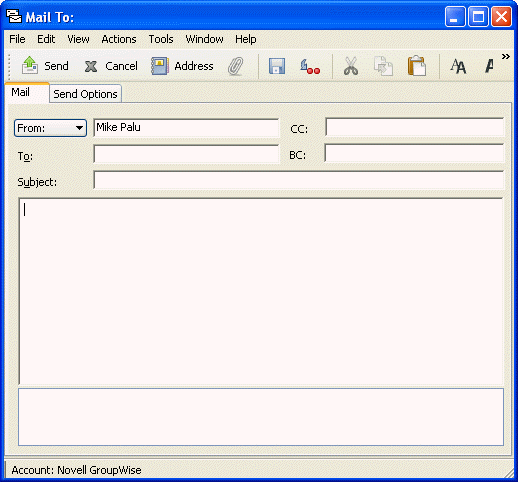
-
In the field, type a username, then press Enter. Repeat for additional users. If necessary, type usernames in the and fields.
or
To select usernames from a list, click on the toolbar, double-click each user, then click .
-
To change the From name (to another account or proxy), click
 , then click a name.
, then click a name.
-
Type a subject.
-
Type a message.
You can specify many options, such as making this message a high priority, requesting a reply from recipients, and more, by clicking the tab.
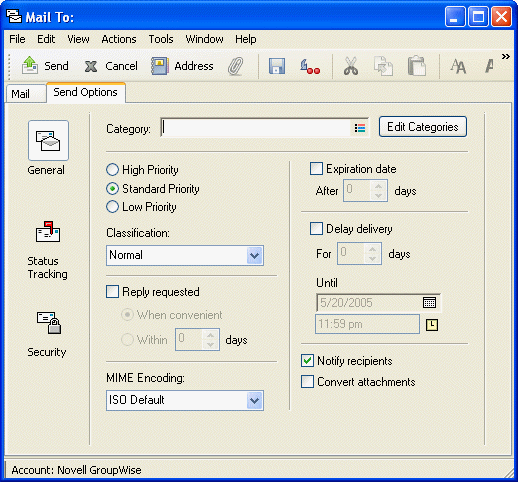
If you want, you can change the font of the message text. For information, see Changing the Font of Items You Send.
-
Include any attachments by clicking
 on the toolbar.
on the toolbar.
-
Click on the toolbar.
3.2.2 Sending Phone Messages
A phone message is a note you can send to notify other GroupWise users of calls they received while they were out of the office or unavailable. Phone messages are stored in the recipient’s Mailbox. You cannot answer your phone from a phone message.
You can change the phone messages you receive into tasks, reminder notes, or other posted item views. This way, you can leave a record of the conversation on the date it was held (reminder note) or create a to-do item to complete at a later date (task). See Changing Item Types.
-
Click > > .
You can place a button on the toolbar. See Customizing the Toolbar Display.
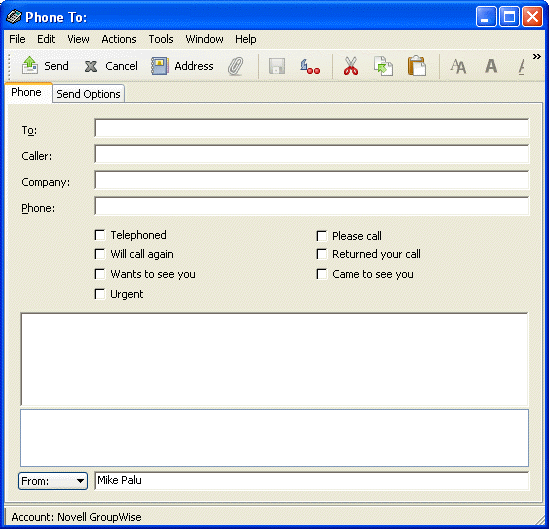
-
In the field, type a username, then press Enter. Repeat for additional users. If necessary, type usernames in the and fields.
or
To select usernames from a list, click on the toolbar, double-click each user, then click .
-
Type the name, company, and phone number of the caller.
-
Select the check boxes that apply to this phone message.
-
Type the message in the field.
If you want, change the font of the message text. For information, see Changing the Font of Items You Send.
-
To change the name (to another account or proxy), click
 , then click a name.
, then click a name.
-
Click on the toolbar.
3.2.3 Changing the Font of Items You Send
The recipient of an item sees the changes you make in Plain Text view if he or she views the item in Plain Text view. The recipient of an item sees the changes you make in HTML view if he or she views the item in HTML view. You might want to let the recipient know which view you composed the item in.
This section contains the following topics:
Changing the Font in Plain Text View
-
In an open item you are composing, click > .
-
Click the field.
-
Click > , then click again.
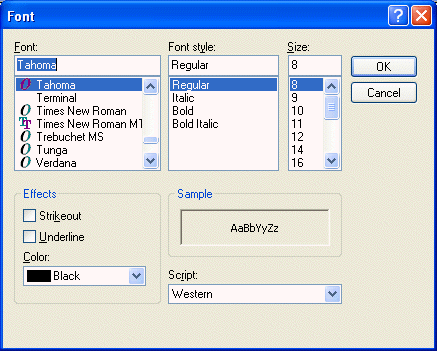
-
Click a font and a font style.
-
Click a size.
-
Click any other options you want to change, then click .
You can also bold, italicize, or underline portions of text using toolbar buttons.
Changing the Font in HTML View
-
In an open item you are composing, click > .
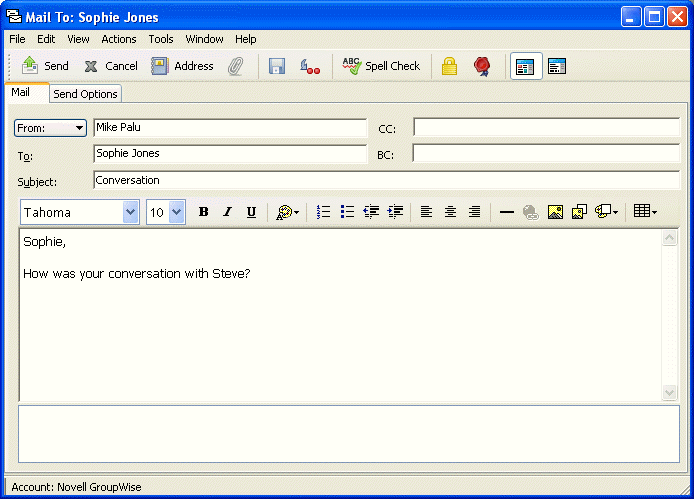
-
Use the HTML toolbar to change the font, add background colors, add images, and more.
You might need to re-size the item view horizontally to see all the buttons on the HTML toolbar.
You can set a default font for items you compose in HTML view. For information, see Viewing and Composing Items in HTML.
3.2.4 Formatting Bulleted and Numbered Lists
You can easily include bulleted and numbered lists in messages.
Formatting Lists in Plain Text View
In an open item you are composing in Plain Text view:
-
Press Ctrl+Shift+L to insert a bulleted list.
-
Press Ctrl+Shift+L again to change it to a numbered list.
-
Continue to press Ctrl+Shift+L to select from the six list formats available.
-
Type the list item, then press Enter to create the next item in the list.
-
Press Enter twice after the last list item to turn off the list formatting.
Formatting Lists in HTML View
In an open item you are composing in HTML view:
-
Use the HTML toolbar to insert a bulleted or numbered list
-
Type the list item, then press Enter to create the next item in the list.
-
Press Enter, then press Backspace after the last item to turn off the list formatting.
3.2.5 Adding a Signature or vCard to Items You Send
Use Signatures to insert a signature or tag line at the end of items you send. For example, you can have GroupWise automatically list your name, phone number, and e-mail address at the bottom of every item you send. If you have a number of different accounts, including POP3, IMAP4, and NNTP newsgroup accounts, you can create a different signature for each account. You can also create multiple signatures for the same account. Signatures are created in HTML, which allows you to add graphics and formatting to your signature. When you send a text message, the HTML signature is converted to text.
In addition to personal signatures, your system administrator can create a global signature for everyone to use. If the system administrator requires the global signature, it is automatically appended to all items that are sent. If the system administrator does not require the global signature, it is appended to your signature if you already use an existing signature. If you don’t have a signature, the global signature is not added to sent items if it is not required. When you resend an item, the global signature is not automatically added to the message.
You can also have GroupWise automatically add a vCard*, or virtual business card, to the end of messages. GroupWise searches the Address Book for your user information and places it at the end of any messages you send.
This section contains the following topics:
Understanding vCard Files
vCards are electronic business cards formatted according to standards set by the Internet Mail Consortium. A vCard file has a .vcf extension, and you can add the file to your outgoing e-mail items. Third-party companies create software you can use to create vCards that include text, graphics, and sound. When you use GroupWise to generate your vCard, it uses the information from the fields in your Address Book listing.
Viewing a vCard
To view a vCard that has been attached to an item:
-
Right-click the vCard attachment, then click .
For information about importing vCard information into an address book, see Importing Information from a vCard.
Creating a Signature
-
Click > , then double-click .
-
Click the tab.
-
Select , then click .
-
Type a name for the signature, then click .
-
Create your signature in the HTML editor that is provided.
-
Select if you want this signature to be your default signature.
-
Click .
Adding a Signature or vCard to Items
-
To specify a signature for all items, click > , then double-click .
-
Click the tab.
-
Click or .
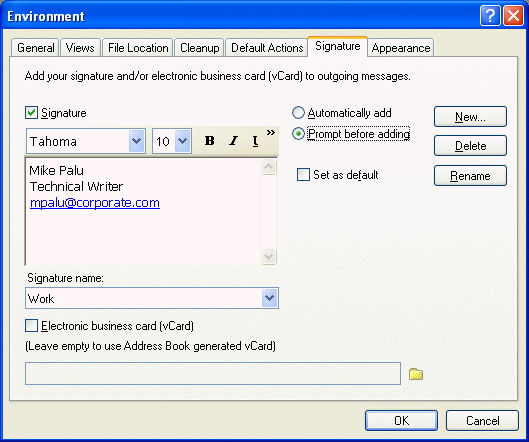
-
If you selected , the signature to use in the drop-down list.
or
If you selected , either specify a .vcf file or leave the field empty to have the vCard use information from your listing in the Address Book.
-
Click a signature option.
-
Click .
You can have both a signature and a vCard at the same time.
3.2.6 Spell-Checking Items You Send
There are two ways to spell-check the items you send. Quick Speller checks the spelling as you type, and underlines the words that are spelled wrong. You run Spell Checker separately, either manually or by selecting to have it run when you click .
Both features check for misspelled words, duplicate words, and irregular capitalization in items you are creating.
When Quick Speller finds a misspelled word, you can replace it with a word Quick Speller suggests or always skip the word for that message. You can also add the word to a user word list.
When Spell Checker finds a misspelled word, you can replace it with a word Spell Checker suggests, edit the word manually, or skip the word. You can also define an automatic replacement for the word, or add the word to a user word list.
You use Environment Options to set up Spell Checker to automatically spell check your messages before you send them.
This section contains the following topics:
Spell-Checking an Item with Quick Speller
-
Right-click the misspelled word in the or field.
-
Click the correctly spelled word.
or
Click to skip the word in the rest of the message.
or
Click to add the word to your word list.
Disabling Quick Speller
-
Right-click the misspelled word in the or field.
-
Click .
To re-enable Quick Speller, right-click in the or field, then click .
Spell-Checking an Item with Spell Checker
-
Click the or field.
or
Select the text to spell-check.
-
Click > .
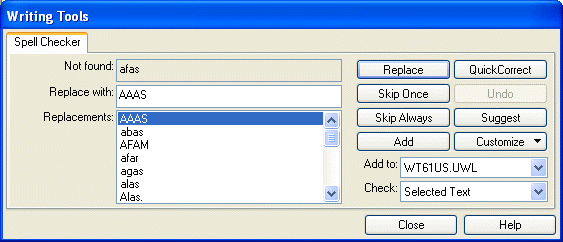
-
To specify a user word list to add words to, click the drop-down list and select an option.
-
To specify a range of text to check, click the drop-down list and select an option.
-
When Spell Checker stops on a word, click any of the available options, or edit the word manually.
You can choose from the following options:
Replace: Replaces a misspelled word with a word Spell Checker suggests. To replace a misspelled word, double-click the word or click the word, then click . To make your own corrections, edit the word in the field, then click .
Skip Once: Skips the word one time. Spell Checker stops the next time it encounters the word.
Skip Always: Skips every occurrence of the word throughout the document. Spell Checker ignores the word until the next time you spell-check.
Add: Adds the word to the current user word list, which stores supplemental words so that Spell Checker can recognize the word in future spell-checks.
QuickCorrect: Defines an automatic replacement for a word or phrase. When Spell Checker stops on a word, click to replace the word with the text in the field and add the replacement to the user word list QuickCorrect* uses. Next time you type the word, QuickCorrect automatically replaces it.
Suggest: Displays additional words or phrases in the list box.
-
Click when spell-checking is complete.
Setting Spell-Checking Options for All Items
You can set GroupWise to automatically spell-check items every time you click .
-
Click > , then double-click .
-
Toggle the check box for and , then click .
Editing Your User Word List
Changes you make in a user word list are effective only if you have QuickCorrect turned on. In the Message box of an item you are creating, click > , then make sure the check box has a check mark.
For more information about user word lists, click > in an item you have created. In the Writing Tools dialog box, click , click , then click .
To make changes in your user word list:
-
In the Spell Checker, click > , then click the list you want to modify.
If you haven’t added lists of your own, the default word list is the only list available.
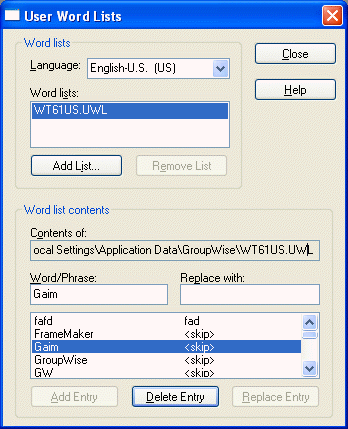
-
To add a new entry, type it in the field, then click .
or
To delete an entry, select it, then click .
or
To change an entry, select it, make the changes, then click .
-
Click when you have finished making changes.
Configuring Spell Checker Language
-
Click the field or the field.
or
Select the text to spell-check.
-
Click > .
-
Click > .
-
Select the language to use, then click .
-
Click .
3.2.7 Undoing the Last Text Action
You can undo the last text action in the Subject or Message field of a message you are composing.
-
Click > .
You can also undo an action by pressing Ctrl+Z. (For information about other shortcut keys, see Section 1.9, Using Shortcut Keys.)
3.2.8 Delaying Delivery of an Item
Delay Delivery allows you send an item at a different time than when you composed the item.
-
From the new item window, click the tab.
-
Select .
-
Specify the number of days to wait until delivery.
or
Specify the date and time to use for delivery.
-
Click .
3.2.9 Using Custom Views
Custom views make it possible to create an e-mail template, then save that template to use again. This is helpful when you want to frequently send an e-mail that has certain text or certain appearance. You can create an e-mail message with your desired look and feel, then save that e-mail message as a custom view.
Saving a Custom View
-
Click
 to create a new e-mail message.
to create a new e-mail message.
-
(Optional) Type the subject of the e-mail message in the field.
-
Type the message of the e-mail in the field.
-
Click > .
By default, a custom view is saved in the C:\Novell\Groupwise directory. Custom view files have a .vew file extension.
Opening a Custom View
-
Click the down-arrow next to the icon.
-
Select the custom view file you saved earlier.
The custom view opens, displaying the information you entered when you saved the custom view file.
-
Added any additional information as needed, then click .